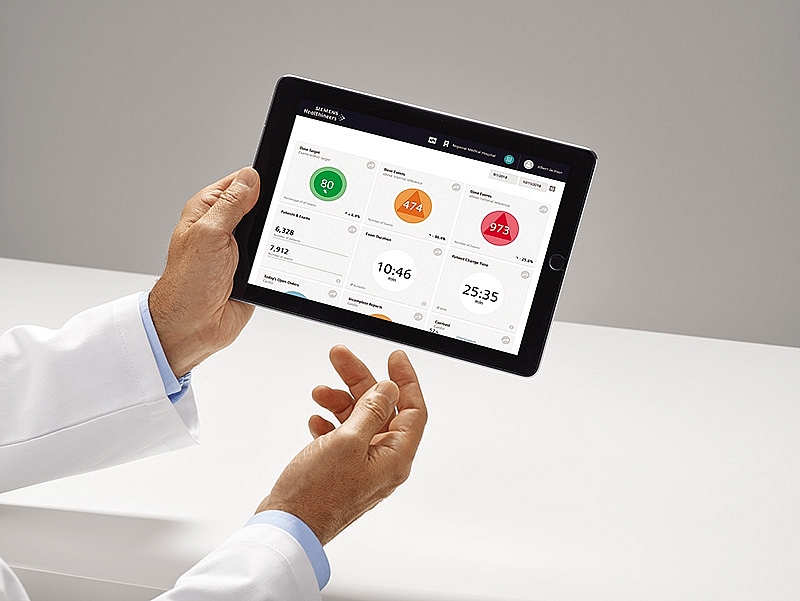The power of digitalising healthcare in Vietnam
 |
| Fabrice Leguet, managing director of Siemens Healthineers in Southeast Asia |
Healthcare organisations and providers worldwide are under pressure to deliver more and better care with limited budgets. In both developed and emerging economies, demand for healthcare services is increasing as the population ages and the burden of chronic disease grows. Emerging economies have their own challenges, such as underdeveloped healthcare infrastructure, smaller spending pools per capita, and the rising prevalence of chronic conditions such as cancer or diabetes.
About 80 per cent of diabetes-related deaths occur in middle- and low-income countries and diabetes deaths worldwide are rising, as are deaths from cardiovascular diseases and cancer. While the Vietnamese healthcare system has made tremendous progress in recent years, it still falls under this category.
The rallying cry among healthcare policymakers and health system executives these days is “high-value care,” and it is a goal that all can support: high return on investment healthcare that delivers a strong outcome weighed against cost. One result of this emphasis is increased focus on the primary care provider, because preventing disease rather than treating it afterwards is better for the individual and cheaper for healthcare systems.
Substantial efforts have been made recently in Vietnam under the leadership of the Ministry of Health to improve such primary care capabilities, with concrete action to make sure that healthcare at the grassroots level becomes the foundation of the country’s healthcare system.
Technology that empowers providers and patients, who are increasingly becoming healthcare consumers, while enabling greater efficiency in healthcare delivery, will be the catalyst for change.
Specifically, this will include technology that opens up access to more convenient settings, including the patient’s home; enabling remote monitoring of patients; giving individuals knowledge of their own wellness; increasing accuracy and efficiency; permitting seamless communication among providers; and leveraging AI for more accurate diagnostics and better-targeted treatments.
Future trends
The proliferation of mobile apps to help people manage their own health promises to make a real change in individuals’ lives. As of last year, about 1.7 billion people worldwide have used mobile health apps.
They offer a chance for individuals to identify problems early on, while motivating them to adopt better health behaviours. In emerging markets the rise of these apps, including those that connect with providers, may allow better healthcare infrastructure that leapfrogs models in more mature economies and better meets consumer needs.
As electronic records and health information exchange proliferate, a greater quantity of patient data is available from more sources than ever before. The challenge of all this data is how to make sense of it and that is where AI opens astonishing possibilities.
Today, AI helps patients better safeguard their own health while creating a learning health system in which outcomes are registered in real time and used to continually refine diagnosis and treatment. AI is currently being applied to everything from drug discovery to radiologic image interpretation, offering insights into disease subtypes and progression that allow for better treatment.
Any kind of device that senses and communicates health data is part of the so-called healthcare Internet of Things (IoT). Expectations of growth in this sector are robust. Data interoperability is one key to reaping the benefits of this sector, but advances are being made at record pace globally.
The potential upsides in the digital transformation of healthcare in the next three to five years are significant, for healthcare systems, payers, and consumers alike. And of course, they are also significant for smart organisations that find hi-tech solutions to healthcare’s biggest challenges, while meeting consumer demand to be informed guardians of their own health.
 |
| Digitalisation is leading to massive recalibrations in the methods of health information storage and the evolution of diagnosis and treatment |
Digitalisation in Vietnam
Some of these future trends could sound distant from the Vietnamese healthcare system as we know it today. However, it is fair to expect that the country will leapfrog into a digitally-connected healthcare world in the coming years.
Indeed, technology adoption is happening at a tremendous pace in Vietnam. However, at the same time, consumers are getting engaged in the healthcare process, for instance exploring the options available of healthcare providers for better treatment. These factors will further create a pull for technology adoption.
The healthcare system in Vietnam has proven its ability to attract investors and develop at a very fast pace. Healthcare IT infrastructure in Vietnam, on the other hand, is a greenfield zone, where exists a tremendous scope to apply digitalisation, leverage newer technologies, and not really focus on upgrade or integration costs of older systems. However, for this to happen in a highly-regulated and sometimes resilient healthcare sector, a few prerequisites are necessary.
Healthcare leaders in this country will need to comprehend the potential benefits of digitalisation in terms of quality and efficiency of care. They will also be required to understand implications with respect to business models, return on investment, cybersecurity, holistic implementation, and the education of various stakeholders.
The regulatory, reimbursement, and budgeting frameworks will need to be adapted to enable and even stimulate such investments in IT, which will become an important part of the overall healthcare budget of the country. Some significant efforts will be required to set the foundations of such digital infrastructure, without which it might be difficult to deploy advanced applications.
The role of Siemens Healthineers
Siemens Healthineers is a leading medical technology company with over 170 years of experience globally. We have served as a pioneer in AI development for more than 20 years and new deep learning technology now enables us to automate complex diagnostics and support optimal treatment. We own more than 500 patent families related to machine learning, more than 125 patent families thereof are related to deep learning.
We have a long history in Vietnam as a technology and service provider, as well as an education partner.
Some of our digital offerings include post-processing solutions to support radiologists in interpreting medical images; diagnostics data archiving and communication systems; teleradiology; medical laboratory data and process management systems; online training management platforms; and hospital asset optimisation solutions.
Digitalisation is an obvious prerequisite for Vietnam to focus on high-value care, while optimising resources and keeping its total healthcare costs at sustainable levels in relation to GDP. We feel it is a very exciting time for healthcare digitalisation across the country.
What the stars mean:
★ Poor ★ ★ Promising ★★★ Good ★★★★ Very good ★★★★★ Exceptional
Themes: Healthcare
Related Contents
Latest News
More News
- Protect what’s next: towards a future free from meningococcal group B disease (December 05, 2025 | 18:00)
- New ILO report offers policy recommendations for disability inclusion (December 04, 2025 | 15:18)
- Maternal job loss may affect children’s mental health, research shows (December 03, 2025 | 19:11)
- Women lead Vietnam’s shift to climate-resilient agriculture (December 03, 2025 | 19:10)
- Experts highlight unpaid care work as key barrier to gender equality (December 03, 2025 | 15:15)
- Opportunities and inequalities for women workers in Vietnam's garment industry (December 03, 2025 | 09:00)
- Vietjet flights carry love to devastated central region (November 28, 2025 | 11:35)
- New initiative to boost the fight against domestic violence (November 26, 2025 | 10:00)
- South Korea funds IOM relief for Vietnam’s typhoon-affected communities (November 24, 2025 | 15:33)
- AI and human-centred values set to shape the future of HR in Vietnam (November 21, 2025 | 18:04)

 Tag:
Tag:




















 Mobile Version
Mobile Version